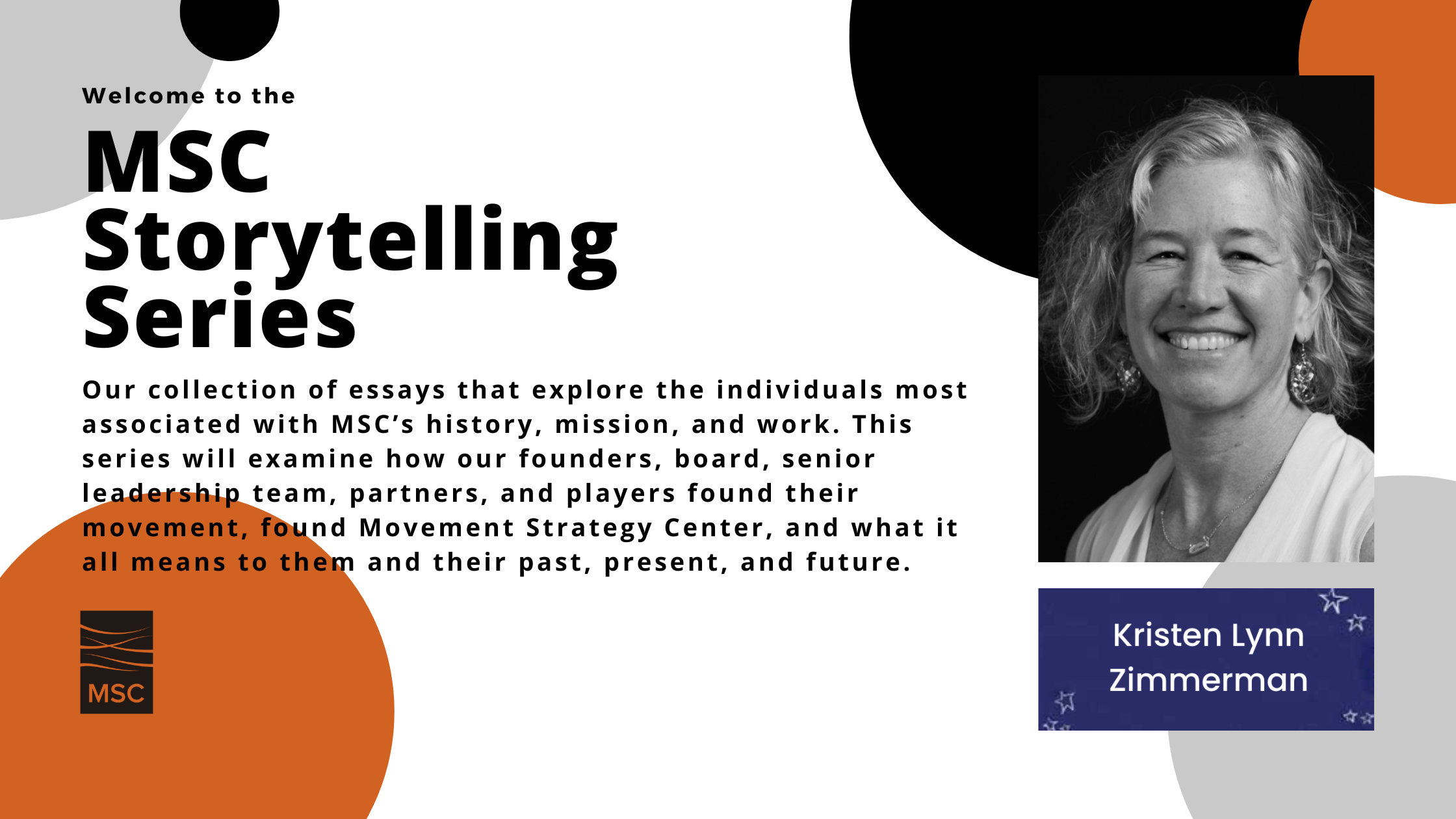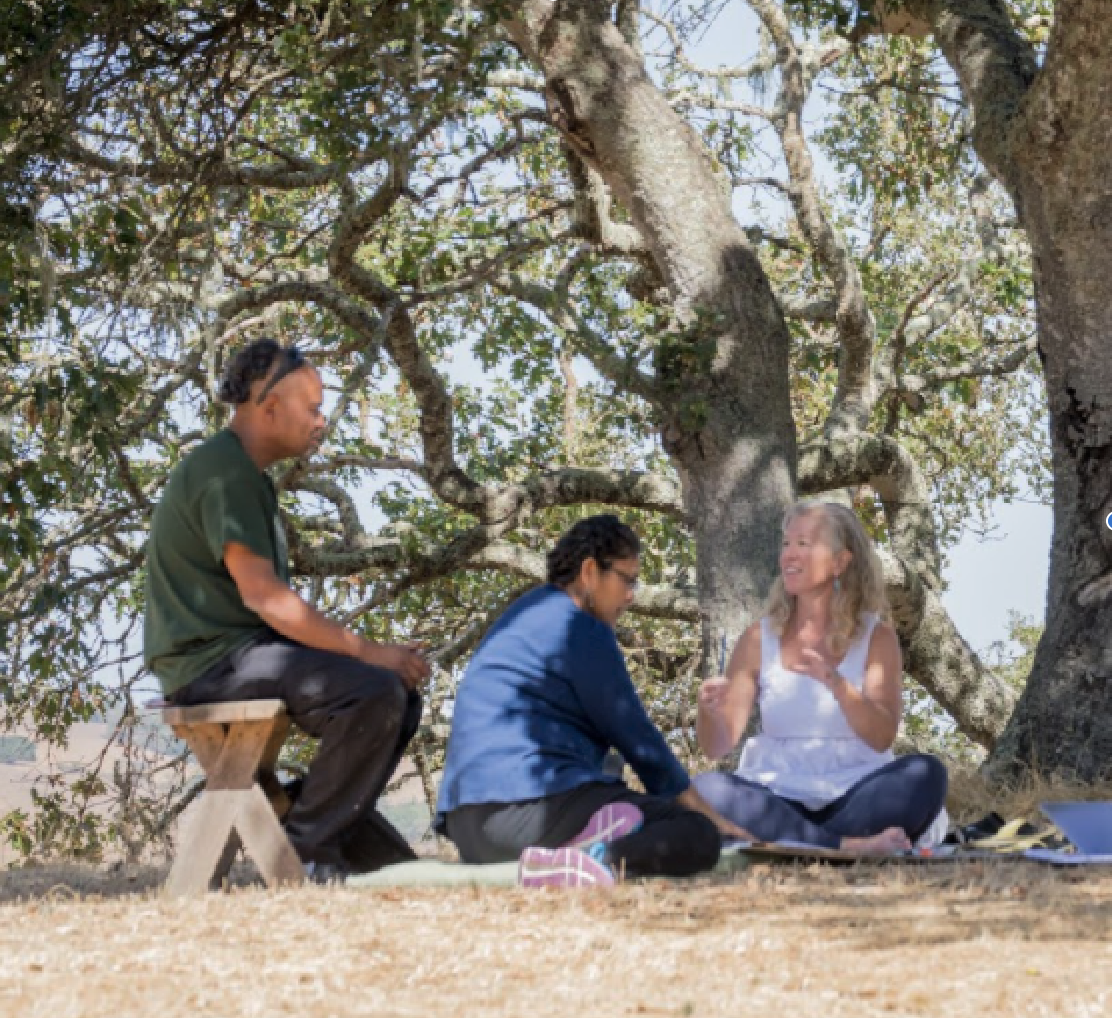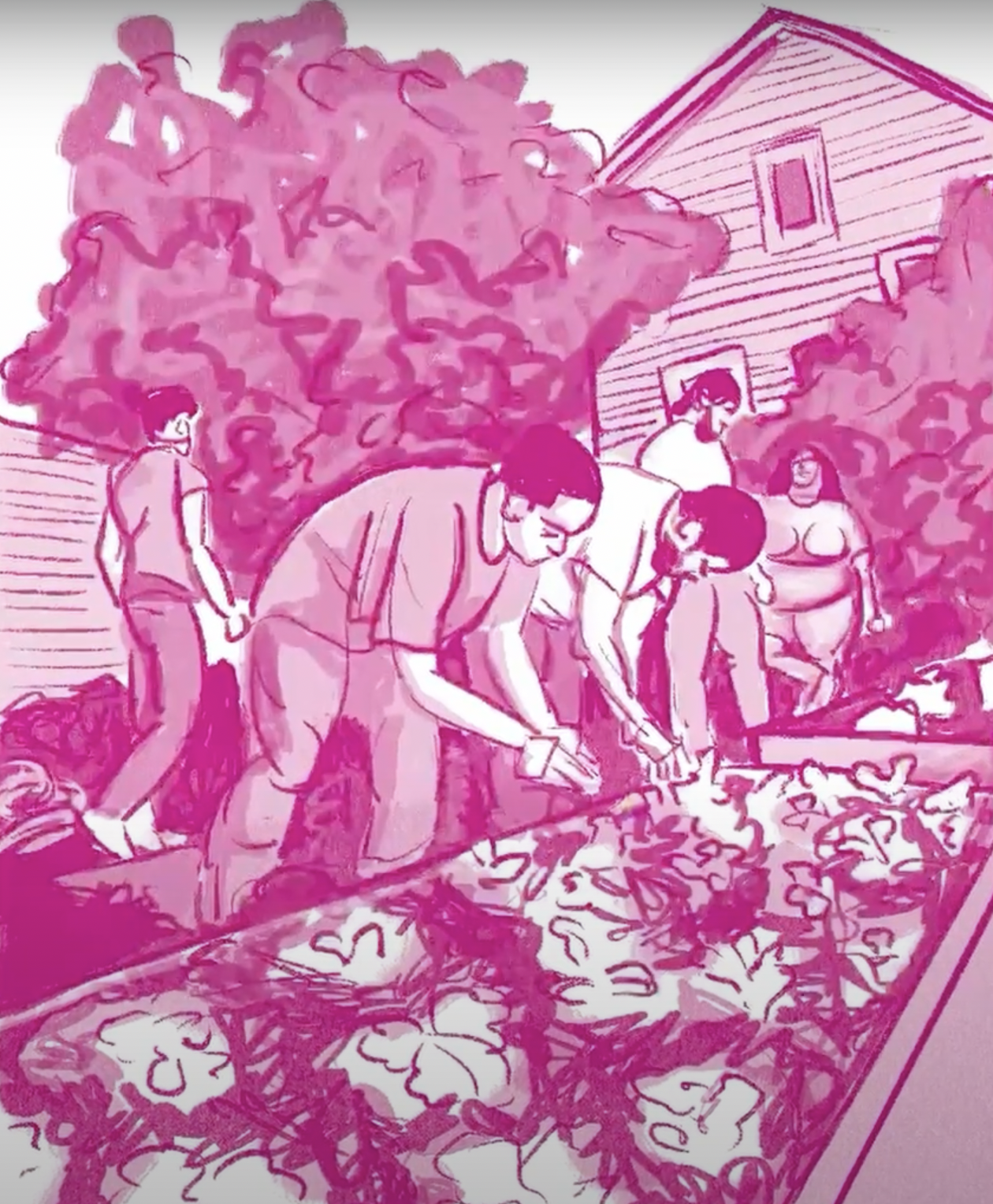Our Storytelling Series Features the Folks Most Associated With MSC's History: Meet Kristen Zimmerman

In this installment we get to know activist, artist and storyteller Kristen Zimmerman — co-founder of Movement Strategy Center (MSC) and Root. Rise. Pollinate!, and illustrator of the new graphic guide Ten Thousand Beloved Communities, a project of Beloved Communities Network.
“It feels important to start to have other ways of thinking about ourselves or our responsibilities, beyond being an activist or beyond being an advocate or even an organizer,” says Kristen Zimmerman — activist, artist, storyteller, and cofounder of MSC. She continues, “it’s really about … how do you form community?”
Zimmerman “landed in the Bay Area” after a few years working in Asia. Her work in California — much like the work she was doing in Nepal — involved the power of storytelling and culture building, within the spectrum of youth organizing. It was in this work where she crossed paths with Taj James, another of MSC’s co-founders and current Board President. Their first encounter was at an event for an organization called Media Alliance — Zimmerman sensed a “potent connection,” and that the two were “going to know each other for a while.”
She was right: James was also working with youth organizers at Coleman Advocates for Children. He saw a common thread between his work and Zimmerman’s focus on “participatory action research with youth.” She said James understood “how the different offerings and gifts that different people might have fit together,” and quickly pulled her into a youth-led juvenile justice organization in San Francisco. That early collaboration included a study of recommended reforms with “a parallel youth-led research project” that involved interviewing young people and advocacy “around what should happen.” The project “was really powerful” and “impacted a lot of the trajectories of the young people,” many of whom “kept in touch.”
Later, while James “decided he was going to start Movement Strategy Center,” Zimmerman was compelled to document some of the local creative and “youth-led efforts,” that, in her opinion, felt like “a cultural moment.” The work was crucial. At that time, the general perception of young people was that they were largely “jaded and inactive.”
Her storytelling project needed a home, and “none of the established organizations felt right.” She met with James, and they decided her work could be a founding project of whatever it was that James was cooking up. She recalled that everyone involved was “very entrepreneurial,” with projects involving storytelling, personal wellness, alliance building and strategy, social networks, and spirituality. “It was very much just a collection of experiments.”
“We're not therapists, we're not trained to be healers … But we can bring healing and transformation and embodied practice to groups.”
It felt right, and lasting. At one point, Zimmerman found herself “thinking about multiple decades of change” and how it was likely she’d be with MSC for many years of partnership. That “culture shift” around sustainable organizing appealed to her — especially the focus on collaborative alliances that eliminated the ways organizers often competed with each other for resources.
Even so, organizing was exhausting. There was a realization that “we’re not therapists, we’re not trained to be healers … But we can bring healing and transformation and embodied practice to groups” by collaborating with people who are focused on individual healing and wellness. That was the aha moment — MSC would be an integration of movement work paired with the holistic, emotional support and spirituality needed to sustain the difficulties of movement work.
Enter Norma Wong: James and Zimmerman met Wong when she was working with Asian Communities for Reproductive Justice — a small organizing group focused on Asian communities in Oakland. The group was experiencing growing pains, and while Zimmerman and James consulted on movement and alliance building, Wong was helping them stay grounded and move through conflict with their vision intact. That intimate collaboration “created the beta template” for MSC.
Wong’s ongoing involvement and expertise kept “integrating the embodiment work with the strategy work.” They landed on applied zone work — “also called forward stance.” Early projects included the Move to End Violence, the Transitions Initiative, the Forward Together project (their first project that was rooted in Indigeneity), and a number of other projects and writings.

Zimmermanm’s sense of spirituality didn’t start with Wong, though. She explained “a difficult relationship with organized religion,” but a familial “connection to land” — forests, forestry, small-scale farming, and nature in general. Years later, she recalled her mother telling her, “oh yeah, [nature is] our family’s spirituality.”
Her art rounded out that sense of spirituality. As an undergrad, Zimmerman majored in visual arts but felt “a little bit like a misfit in the art department.” Unlike many of her peers, her artwork was “always really community oriented” and “story oriented.” A lot was collaborative, involving immigrant and refugee youth as well as young people in domestic violence shelters. The work was a way to center these youths, who could feel misplaced within “their community’s trajectory,” and to help them “have a healing relationship to their story.”
Later, an itch to work abroad coincided with a friend’s return from working in education and storytelling within minority and refugee communities in Nepal and Tibet. Inspired, Zimmerman and her friend wrote letters to the Tibetan Department of Education along with the Tibetan Youth Congress and the Tibetan Women’s Congress, two activist groups. In essence, the letters said, “hey, we have this idea. Is it of use to you?”
That sense of community often seemed so lost in the United States: “it takes so much more energy and feels you have to hold the community together rather than the community holding you.”
That idea became “an intercultural project, doing work both with youth here and youth there, and specifically young people who were navigating questions around identity, belonging, and their own place in a longer arc of their community.” They “collaborated for three years in different spots” with community organizing groups, recent political refugees, elders who had left Tibet, and teachers who were facilitating opportunities for young people to ask questions, develop stories, and interview one another while creating “magazines and exhibits and advocacy efforts.”
The work was a formative experience — “making meaning and helping people find belonging, helping [herself] find belonging,” and learning “how people heal and repair relationships with intergenerational trauma.” Zimmerman “was lucky enough to live in really wonderful communities,” sharing meals, building relationships, and creating art. She had a “visceral sense” of being a guest in a foreign country and in a family’s home, while also “being held by community.” These communities were strong enough to not only support the folks who had always been there, but to hold newcomers. Paired with her exposure to the sense of community in Tibetan Buddhism, she felt inspired “to figure out how to repair and create community in a similar way” at home. That sense of community often seemed so lost in the United States: “it takes so much more energy and feels you have to hold the community together rather than the community holding you.”
“The pollination part feels evocative, it feels more poetic, and it also feels like, yeah, there's a connector part and a life giving part and that feels really important.”
Later, a series of life experiences — the birth of her son, who has Down syndrome, the traumatic loss of her sister when her son was four, and the loss of her mother shortly thereafter — inspired a number of questions: “how do you actually repair human relationships to each other? How do you form functional communities that are really rooted in place? How do you attend to spirit as part of the center of systemic and cultural transformation?”
It all inspired the here and now: in 2018, alongside Shawna Wakefield and Rufaro Gwarada, Zimmerman founded Root. Rise. Pollinate!, an MSN partner. The project supports a transnational community of individual and collective feminist changemakers with learning and networking opportunities as well as regenerative mind-body-spirit practices. The idea of “pollination” is central: collective changemaking “is really about pollinating new ways of being in a new worldview.”
She cited a Transitions Initiative-era question: how do “we jump or leap from cultures rooted in violence and separation, extraction, domination, all of that, to cultures and ways of being and seeing the world that are really rooted in our connection and mutuality and care?” The answer is in forming community and connecting to other communities. It’s “a different way of thinking and being” and “the pollination part feels evocative, it feels more poetic, and it also feels like, yeah, there’s a connector part and a life giving part and that feels really important.”

Now, she is bringing that sense of community and collaboration to a forthcoming graphic novel. In collaboration with Movement Strategy Network (MSN) partner Beloved Communities Network, this graphic guide to building world-transforming communities features writings by 25 leaders, a foreward by adrienne maree brown, and illustrations by Zimmerman. Ten Thousand Beloved Communities is about deepening relationships to people and places through a lens of indigeneity. The book defines the story and lineage of Beloved Community, and features stories of Beloved Community in action along with practices to help readers integrate Beloved Community and the wisdom of the Transitions Initiatives into their daily lives.
MSC’s Transitions Initiative, and the affiliated Labs, are mentioned frequently. Some featured culture nights and, chuckling, Zimmerman told us “you could talk to everybody about their culture night moment.” Normally she might’ve gone “up and painted a painting” but “it’s not the same as performing.” One night she mustered up the courage to sing the Bill Withers classic “Lovely Day.” She said: “It’s a testimony to the community side of the work that I could do that … That people joined in … It was the most beautiful thing and I wasn’t doing it alone, which was awesome.”

